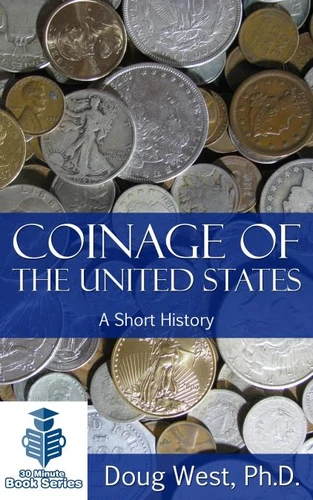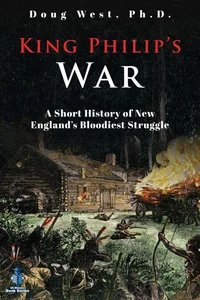Coinage of the United States – A Short History
Par :Formats :
Disponible dans votre compte client Decitre ou Furet du Nord dès validation de votre commande. Le format ePub est :
- Compatible avec une lecture sur My Vivlio (smartphone, tablette, ordinateur)
- Compatible avec une lecture sur liseuses Vivlio
- Pour les liseuses autres que Vivlio, vous devez utiliser le logiciel Adobe Digital Edition. Non compatible avec la lecture sur les liseuses Kindle, Remarkable et Sony
 , qui est-ce ?
, qui est-ce ?Notre partenaire de plateforme de lecture numérique où vous retrouverez l'ensemble de vos ebooks gratuitement
Pour en savoir plus sur nos ebooks, consultez notre aide en ligne ici
- FormatePub
- ISBN978-1-310-06090-8
- EAN9781310060908
- Date de parution29/10/2015
- Protection num.pas de protection
- Infos supplémentairesepub
- ÉditeurJPCA
Résumé
The history of United States coinage is a story that parallels the rise of America. Starting from a humble beginning in a basement in Philadelphia in the first few years of the country to grow to a large highly sophisticated system that produces millions of coins per year. Due to a lack of silver, the first silver coins produced by the Mint came from silverware contributed by George and Martha Washington.
Coins are something we take for granted today and put in jars and baskets on our night stands to accumulate for a rainy day when we need a few extra dollars. For more than half of the history of America, that wouldn't have been possible for the average citizen. It wasn't until after the Civil War that coinage became widely used for all types of transactions. Up until this time, barter and money substitutes, such as, tokens, script, and foreign coins, were used as a mediums of exchange.
During the 1830's and then again during the Civil War, coins were in such short supply that merchants and private individuals took to producing cent sized coins just to make change for the day to day transactions. In America, it was legal up until 1857 to use foreign money in transactions. The Spanish dollars and their fractional parts called "bits" were very common during colonial times up until the mid-1800s.
President Theodore Roosevelt sparked a change in the designs on coins from a standardized institutional theme to more artistic and attractive designs. The President enlisted the help of one of the country's most prominent sculptures to create some of the most beautiful coins in the history of the country and perhaps the entire world. Up until recent times, the value of the silver and gold coins depended on their intrinsic metal value.
This was a constant headache for the Mint, as the value of gold and silver would rise, the coins would disappear from circulation to be melted and sold for their bullion value. It wasn't up until 1964 that the Mint totally abandoned precious metals for the day-to-day coinage and changed the composition to what we see today as modern copper-nickel clad coinage. Come and take the journey into what seems so ubiquitous today, and learn the fascinated history of these little metal objects in our pockets and purses.
Coins are something we take for granted today and put in jars and baskets on our night stands to accumulate for a rainy day when we need a few extra dollars. For more than half of the history of America, that wouldn't have been possible for the average citizen. It wasn't until after the Civil War that coinage became widely used for all types of transactions. Up until this time, barter and money substitutes, such as, tokens, script, and foreign coins, were used as a mediums of exchange.
During the 1830's and then again during the Civil War, coins were in such short supply that merchants and private individuals took to producing cent sized coins just to make change for the day to day transactions. In America, it was legal up until 1857 to use foreign money in transactions. The Spanish dollars and their fractional parts called "bits" were very common during colonial times up until the mid-1800s.
President Theodore Roosevelt sparked a change in the designs on coins from a standardized institutional theme to more artistic and attractive designs. The President enlisted the help of one of the country's most prominent sculptures to create some of the most beautiful coins in the history of the country and perhaps the entire world. Up until recent times, the value of the silver and gold coins depended on their intrinsic metal value.
This was a constant headache for the Mint, as the value of gold and silver would rise, the coins would disappear from circulation to be melted and sold for their bullion value. It wasn't up until 1964 that the Mint totally abandoned precious metals for the day-to-day coinage and changed the composition to what we see today as modern copper-nickel clad coinage. Come and take the journey into what seems so ubiquitous today, and learn the fascinated history of these little metal objects in our pockets and purses.
The history of United States coinage is a story that parallels the rise of America. Starting from a humble beginning in a basement in Philadelphia in the first few years of the country to grow to a large highly sophisticated system that produces millions of coins per year. Due to a lack of silver, the first silver coins produced by the Mint came from silverware contributed by George and Martha Washington.
Coins are something we take for granted today and put in jars and baskets on our night stands to accumulate for a rainy day when we need a few extra dollars. For more than half of the history of America, that wouldn't have been possible for the average citizen. It wasn't until after the Civil War that coinage became widely used for all types of transactions. Up until this time, barter and money substitutes, such as, tokens, script, and foreign coins, were used as a mediums of exchange.
During the 1830's and then again during the Civil War, coins were in such short supply that merchants and private individuals took to producing cent sized coins just to make change for the day to day transactions. In America, it was legal up until 1857 to use foreign money in transactions. The Spanish dollars and their fractional parts called "bits" were very common during colonial times up until the mid-1800s.
President Theodore Roosevelt sparked a change in the designs on coins from a standardized institutional theme to more artistic and attractive designs. The President enlisted the help of one of the country's most prominent sculptures to create some of the most beautiful coins in the history of the country and perhaps the entire world. Up until recent times, the value of the silver and gold coins depended on their intrinsic metal value.
This was a constant headache for the Mint, as the value of gold and silver would rise, the coins would disappear from circulation to be melted and sold for their bullion value. It wasn't up until 1964 that the Mint totally abandoned precious metals for the day-to-day coinage and changed the composition to what we see today as modern copper-nickel clad coinage. Come and take the journey into what seems so ubiquitous today, and learn the fascinated history of these little metal objects in our pockets and purses.
Coins are something we take for granted today and put in jars and baskets on our night stands to accumulate for a rainy day when we need a few extra dollars. For more than half of the history of America, that wouldn't have been possible for the average citizen. It wasn't until after the Civil War that coinage became widely used for all types of transactions. Up until this time, barter and money substitutes, such as, tokens, script, and foreign coins, were used as a mediums of exchange.
During the 1830's and then again during the Civil War, coins were in such short supply that merchants and private individuals took to producing cent sized coins just to make change for the day to day transactions. In America, it was legal up until 1857 to use foreign money in transactions. The Spanish dollars and their fractional parts called "bits" were very common during colonial times up until the mid-1800s.
President Theodore Roosevelt sparked a change in the designs on coins from a standardized institutional theme to more artistic and attractive designs. The President enlisted the help of one of the country's most prominent sculptures to create some of the most beautiful coins in the history of the country and perhaps the entire world. Up until recent times, the value of the silver and gold coins depended on their intrinsic metal value.
This was a constant headache for the Mint, as the value of gold and silver would rise, the coins would disappear from circulation to be melted and sold for their bullion value. It wasn't up until 1964 that the Mint totally abandoned precious metals for the day-to-day coinage and changed the composition to what we see today as modern copper-nickel clad coinage. Come and take the journey into what seems so ubiquitous today, and learn the fascinated history of these little metal objects in our pockets and purses.























